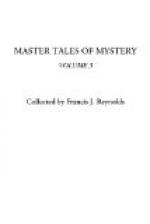“It is like the start of the substituted letter, and the other is like the missing note,” gasped Leland in a daze.
“Yes,” said Kennedy quickly. “Leland, no one entered your office. No one stole the Thurston note. No one substituted the Lytton letter. According to your own story, you took them out of the safe and left them in the sunlight all day. The process that had been started earlier in ordinary light, slowly, was now quickly completed. In other words, there was writing which would soon fade away on one side of the paper and writing which was invisible but would soon appear on the other.
“For instance, quinoline rapidly disappears in sunlight. Starch with a slight trace of iodine writes a light blue, which disappears in air. It was something like that used in the Thurston letter. Then, too, silver nitrate dissolved in ammonia gradually turns black as it is acted on by light and air. Or magenta treated with a bleaching-agent in just sufficient quantity to decolorise it is invisible when used for writing. But the original color reappears as the oxygen of the air acts upon the pigment. I haven’t a doubt but that my analyses of the inks are correct and on one side quinoline was used and on the other nitrate of silver. This explains the inexplicable disappearance of evidence incriminating one person, Thurston, and the sudden appearance of evidence incriminating another, Dr. Dixon. Sympathetic ink also accounts for the curious circumstance that the Lytton letter was folded up with the writing apparently outside. It was outside and unseen until the sunlight brought it out and destroyed the other, inside, writing—a chance, I suspect, that was intended for the police to see after it was completed, not for the defence to witness as it was taking place.”
We looked at each other aghast. Thurston was nervously opening and shutting his lips and moistening them as if he wanted to say something but could not find the words.
“Lastly,” went on Craig, utterly regardless of Thurston’s frantic efforts to speak, “we come to the note that was discovered so queerly crumpled up in the jar of ammonia on Vera Lytton’s dressing-table. I have here a cylindrical glass jar in which I place some sal-ammoniac and quicklime. I will wet it and heat it a little. That produces the pungent gas of ammonia.
“On one side of this third piece of paper I myself write with this mercurous nitrate solution. You see, I leave no mark on the paper as I write. I fold it up and drop it into the jar—and in a few seconds withdraw it. Here is a very quick way of producing something like the slow result of sunlight with silver nitrate. The fumes of ammonia have formed the precipitate of black, mercurous nitrate, a very distinct black writing which is almost indelible. That is what is technically called invisible rather than sympathetic ink.”
We leaned over to read what he had written. It was the same as the note incriminating Dixon:




